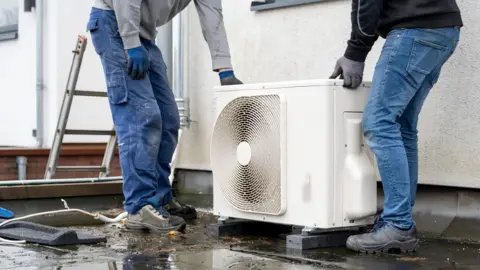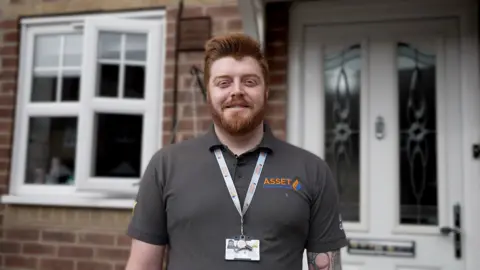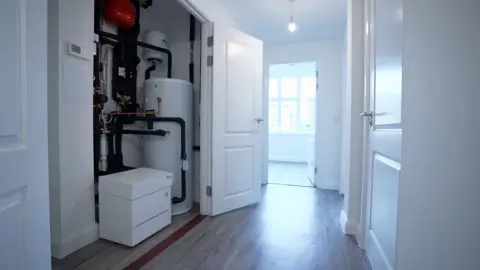Planning change to make installing heat pump easier for millions
 Getty Images
Getty ImagesA key planning restriction that heat pumps need to be one metre from a neighbour's property has been lifted as the government seeks to accelerate the take up of the low-carbon technology.
The change, which is part of the government's Warm Homes Plan to lower household bills and cut planet warming emissions, means it could be easier for millions of homes in England to have a heat pump installed.
But consumer groups warn that the changes will not help those in rented or leasehold properties and the biggest barrier to installing a heat pump remains the high upfront costs.
This is a particular problem for older housing stock where upgrades to pipework and insulation may also be required.
Most UK homes use gas boilers for their hot water and heating, but this produces up to 14% of the country's planet warming greenhouse gases.
In comparison, heat pumps use electricity, so as the country moves to generating more electricity from renewable energy sources like solar and wind, they could produce far fewer emissions than boilers.
But switching from a gas boiler to a heat pump is expensive and not straightforward if you live in one of England's six million terraced homes.
Until Thursday, homeowners needed planning permission if they wanted to put a heat pump within one metre of their neighbour's property - because of concerns over noise.
Tom Clarke, a gas engineer who recently retrained to fit heat pumps, said having to apply for planning permission had been a barrier for his customers.
"When you look across London we have loads and loads of terraced houses and no matter where you site the appliance it is always going to be within one metre of the boundary," he said.
It was particularly problematic for people replacing a broken gas boiler because many customers would not want to go more than a month without heating waiting for council approval, he said.
This is echoed by Octopus Energy, who told parliament's Energy Security and Net Zero (ESNZ) Committee in 2023 that this planning rule was affecting 27% of its customers.
"Those who try to proceed end up waiting an additional eight to 10 weeks on average. Even if customers meet all the requirements, there is no guarantee that local councils will grant the permission, as they all have different interpretations of central planning guidelines," the company wrote in its submission. "The combined impact of all these things mean that very few of the 27% of customers who require planning have made it to install."
The rule has now been dropped to accelerate the uptake of heat pumps. Previous concerns over noise are less of an issue with newer devices, though units will still be required to be below a certain volume level.
The planning changes also include a relaxation of the rules for the size and number of heat pumps households can install.
Households most likely to be affected are those living in terraced housing. In 2021, they accounted for 5.7 million households, or 23% of the total. Some of these will still need planning permission, for example those living in conservation areas.
 Kevin Church/BBC
Kevin Church/BBCThe change is part of the government's Warm Homes Plan which aims to give 300,000 households upgrades to improve their energy efficiency and lower bills.
Although the heat pump industry welcomed the changes, many point out the main barrier for many customers is that installing heat pumps is expensive, particularly in older houses, where better insulation may also be needed.
This was the case at social housing estate Sutton Dwellings in Chelsea, London, which underwent a full refurbishment of its fabric alongside a new ground source heat pump network.
Its landlord, Clarion Housing Group, did receive a grant from the government to install the new network but also invested its own money.
Stuart Gadsden, commercial director at Kensa, the company which designed and installed the system, said this was an issue for many landlords: "A big [barrier] is funding, this obviously does cost more to install than a traditional gas boiler system.
"In the social housing sector we have funding from the warm homes social housing fund, but it was oversubscribed by double. Lots of housing associations want to put low carbon heating in but there is not enough to go around."
 Kevin Church/BBC
Kevin Church/BBCRenters have to rely on landlords being willing to make the initial upfront investment.
Rob Lane, Chief Property Officer at Clarion, said the company was happy to do this at Sutton Dwellings because of the impact for residents: "We're waiting to see how the costs of running this system bear out, but our forecasts suggests that each home is going to cost on average £450 - £500 per home (each year) - considerable savings for residents."
From 2030, as part of the Warm Homes plan, there will be mandatory requirements for all private landlords to upgrade the energy efficiency of their properties.
But the way that Energy Performance Certificates (EPC) are currently calculated means a gas boiler can sometimes have a better rating than a heat pump because it looks at energy costs and assumes gas is cheaper.
Katy King, deputy director of sustainability at charity Nesta, said the government could bring down electricity costs.
"The UK has some of the most expensive electricity prices in Europe. The government could take levies off electricity and put them onto gas or use general taxation. It is a tricky choice and one we do expect them to be consulting on within the year," she said.
A spokesperson from the Department of Energy Security and Net Zero said: "We are supporting industry to develop financing models that can remove the upfront cost entirely, and consulting on new approaches, such as heat pump subscriptions, to help more households make the switch to cleaner heating in a way that works for them."

Sign up for our Future Earth newsletter to keep up with the latest climate and environment stories with the BBC's Justin Rowlatt. Outside the UK? Sign up to our international newsletter here.
